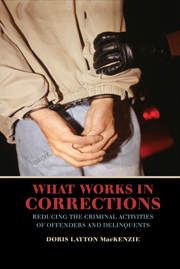Book contents
- Frontmatter
- Contents
- Acknowledgments
- PART ONE STRATEGIES FOR REDUCING CRIME
- PART TWO THE EFFECTIVENESS OF REHABILITATION PROGRAMS
- PART THREE TARGETING SPECIFIC TYPES OF OFFENDERS
- 8 Sex Offender Treatment
- 9 Juvenile Delinquents
- 10 Domestic Violence Offenders
- PART FOUR MANAGEMENT AND TREATMENT OF SUBSTANCE ABUSERS
- PART FIVE CONTROL, DISCIPLINE, AND PUNISHMENT
- PART SIX CONCLUSIONS
- References
- Index
- CAMBRIDGE STUDIES IN CRIMINOLOGY
9 - Juvenile Delinquents
Published online by Cambridge University Press: 27 July 2009
- Frontmatter
- Contents
- Acknowledgments
- PART ONE STRATEGIES FOR REDUCING CRIME
- PART TWO THE EFFECTIVENESS OF REHABILITATION PROGRAMS
- PART THREE TARGETING SPECIFIC TYPES OF OFFENDERS
- 8 Sex Offender Treatment
- 9 Juvenile Delinquents
- 10 Domestic Violence Offenders
- PART FOUR MANAGEMENT AND TREATMENT OF SUBSTANCE ABUSERS
- PART FIVE CONTROL, DISCIPLINE, AND PUNISHMENT
- PART SIX CONCLUSIONS
- References
- Index
- CAMBRIDGE STUDIES IN CRIMINOLOGY
Summary
THE JUVENILE JUSTICE SYSTEM
The first juvenile court in the United States was established more than one hundred years ago in Chicago. Prior to this, children as young as seven were processed the same as adults. They could stand trial in criminal court and be sentenced to prison or death. The juvenile court reflected a change in the philosophy toward juveniles. The new courts focused on the welfare of the child. The delinquent child was viewed as in need of benevolent intervention from the court. Juvenile courts sought to rehabilitate delinquents so they would become productive members of society. By 1925, all but two states had established either juvenile courts or probation services for juveniles. During the next fifty years, juvenile courts in most states had exclusive jurisdiction over all youth under age eighteen who were charged with violating criminal laws.
As occurred with adult offenders in the United States, attitudes toward the rehabilitation of juveniles changed during the 1970s. There was less support for rehabilitation. The public perceived that serious juvenile crime was increasing and that the system was too lenient with juvenile delinquents. In response, many states passed more punitive laws. Some of these laws removed young lawbreakers from the juvenile system and required that they be tried in adult criminal courts. During the 1990s, all but three states passed laws designed to crack down on juvenile crime. These laws expanded eligibility for criminal court processing and adult correctional sanctioning and reduced confidentiality protections for juveniles.
- Type
- Chapter
- Information
- What Works in CorrectionsReducing the Criminal Activities of Offenders and Deliquents, pp. 168 - 191Publisher: Cambridge University PressPrint publication year: 2006



